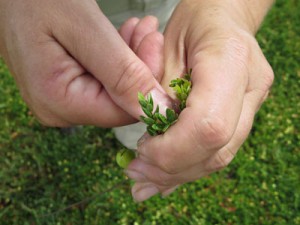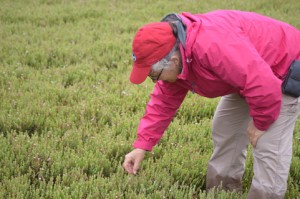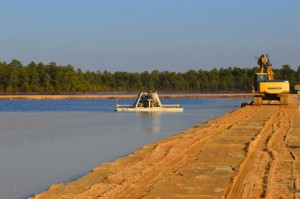Our team just finished another productive follow-up visit with soil scientist Dr. Joan Davenport! Joan comes to see us in the spring during the bloom period and again in the height of summer to discuss fertilizer needs for bud set. “At this point in the growing season, we are evaluating the plants to complete the grown season and support next year’s crop. To do this, I look at the crop load, the presence and quantity of buds, the length and color of the new upright growth, the color of last growing season’s leaves. This season’s new leaves should be green and the old (last year’s) leaves just starting to turn pale. Larger crop loads indicate higher N[itrogen] demand. There should be visible buds and few to no uprights actively growing, plus few to no runners present,” Joan says.
“In May it’s the beginning of the growing season, so she’s basically helping us make nutrition decisions for the highest demand time of year, bloom and fruit set,” says manager Mike Haines. “She’s here to help make sure we get this crop growing nice and healthy.” For this, Joan looks at hook, the length and color of the new upright growth, and the amount and color of old leaves, including looking for leaves from two growing seasons ago.
‘This time of year we’re looking at recommendations for bud set fertilizer,” Mike says. “We have to make sure the plants have enough to maintain the fruit as it finishes sizing up before harvest, but also that the plants set buds for next year’s crop. So at all times, we’re thinking about this year and the next, but that’s it goes with a perennial crop; all the years are related.” A follow-up visit is always useful for the team. “After we start to implement her recommendations, we do adjust as needed based on observation; stuff always happens that we don’t expect. At Sim Place, we sanded a lot of beds this year for the first time ever, and it’s pretty mucky soil out there. The sand seemed to really stimulate growth even more than we would have wanted in some places, so we cut back on fertilizer there. Conversely, on the home farm at Boricua, we have new plants but it’s really sandy. The water drains pretty quickly and there’s not a lot of organic matter in the soil so we added much more fertilizer than we originally planned to there.”
“It’s going to take eyes on the beds,” Joan says. “But here, there are always eyes on the beds.” And as always, our PIICM team is out doing whatever it takes to make sure our growing season gives us good results!



